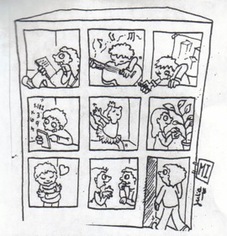I believe that language is so flexible, that the way we learn it can be done as flexible as well. I found the proof of my belief after doing microteaching simulation in LTM class with my group and looking at other groups’ performance. When we teach writing, for example, we can also put some activities supporting speaking, or even listening skills. I use the example from my own group performance. At the beginning, we do a storytelling—which is a typical speaking activity—as an elicitation. Later on, after having “our students” listen to the story, we can easily help them to identify the stages of the story—which is a narrative story—such as what happened at the beginning, when the problem raised and solved, etc. yes, I prefer this way to tell them directly the generic structure and the language features. I think, by doing this, students are encouraged to think and find the pattern by themselves. It hoped that the concept will remain longer in their mind.
I also believe that the best method in teaching writing is by using “process approach” since I’ve found many facts say that everything instant will not give a good impact. So does writing. By steps I learnt from last Bahasa Indonesia class (which are shown interestingly below), I hope students will have more will to write well.
By these steps also, I want they know that ideas for a story can come from everywhere, even from a story that is seen from different perspective. Here, I want to tell them that language learning should be fun. We can be anyone when we write, right? Moreover, if we give them opportunities to read the story and act it out. I think, these steps can gain their intrinsic motivation and confidence, so they will dare to take risks in writing, as the principles proposed by Brown (2007).
Well, even though all performance of each group seemed good, there are some weaknesses I found repeatedly done. Some of us just put some interesting activities without considering the relation with the material they deliver. It could be nice for students yet confusing; they may asked, “What are these games for?” Actually, I don’t bother what kind of game they used as long as it was related to the subject and they tell students the connection or the objective of the game.
Another weakness is misusing of a certain term improperly. For instance, one of the groups taught speaking but they tended to emphasize the generic structure of a text. Although I believe that language learning should be flexible, I don’t see any sense on that. Maybe they could mention it at a glance, but they don’t need to elaborate on each step since it’s more suitable to be done in writing class. Regardless all those weaknesses, I’m really proud with my lecturers and my friends who can deliver a material in a fun yet understandable way. I wonder how happy their students will be having them as the teacher. J




